
Crocodiles have been around for millions of years, which speaks volumes about their survival strategies. Think of them as ancient warriors, perfectly equipped for their environment with a unique set of skills and traits. From their rugged skin to their impressive hunting tactics, there’s a lot to learn about how these reptiles thrive where many others would struggle. Let’s dive deeper into the various ways crocodiles adapt and survive in harsher climates.
Physical Adaptations: Nature’s Armor
Crocodiles come equipped with a variety of physical adaptations that help them endure extreme conditions. Their tough, scaly skin not only acts as armor but also helps them retain moisture. In environments where water isn’t always readily available, this is crucial. Imagine trying to survive in the desert without any water; a crocodile’s skin minimizes water loss, allowing it to stay hydrated for longer periods.
Another striking feature is their powerful jaws. With a bite force stronger than that of any other animal, crocodiles can capture and hold onto prey with ease. This biting power allows them to hunt effectively, whether they’re lying in wait in the water or launching a surprise attack on land. Their serrated teeth, designed for gripping rather than chewing, show just how well-adapted they are to their hunting lifestyle.
Crocodiles are also experts at thermoregulation. They can’t generate their own body heat, so they often sunbathe on rocks or riverbanks to maintain their body temperature. When it gets too hot, they retreat to the water to cool off. This clever behavior helps them survive in harsh environments where temperature fluctuations can be extreme. You might say they’ve found their own version of a weather app, responding to their surroundings to stay comfortable and safe.
Behavioral Adaptations: Survival Strategies
Behavior plays a massive role in how crocodiles thrive. These reptiles are incredibly patient hunters; they can sit motionless for hours, waiting for the right moment to strike. This tactic saves energy and increases their chances of catching prey. It’s like fishing without bait; they simply wait for a meal to come to them.
In harsh climates, crocodiles also exhibit social behaviors that enhance their survival. For instance, they can be seen basking together during the day to conserve heat. By huddling up, they reduce the amount of energy lost to the environment. This behavior not only helps them stay warm but also offers protection against potential threats.
Interestingly, crocodiles communicate with each other through vocalizations. They use various sounds to express distress, assert dominance, or attract mates. This form of communication is essential in their harsh habitats, where clear signals can mean the difference between life and death. You might be surprised to learn that even a simple croak or hiss can have significant implications for their survival.
Diet and Feeding Habits: Masters of the Meal
Crocodiles are opportunistic feeders, meaning they’ll eat whatever is available. This flexibility in diet is crucial for survival in harsh environments where food might be scarce. Their diet primarily consists of fish, birds, and mammals, but they won’t hesitate to scavenge if necessary. Think of them as the ultimate survivalists—if it moves and they can catch it, it’s fair game.
One fascinating aspect of crocodile feeding is their ability to consume large amounts of food at once. When they make a kill, they can eat up to half their body weight in one go. This allows them to store energy for long periods, which is vital when hunting opportunities are limited. It’s like filling up your car’s gas tank; they’re ready to go when the next meal comes along.
Crocodiles also have a unique way of catching prey. They can perform a swift, death roll to subdue larger animals, spinning violently to tear apart their meal. This tactic minimizes the struggle and makes it easier to consume prey even in tough conditions. It’s one of those “ninja” moves that highlights just how effective they are as hunters.
Habitat Preferences: Finding Shelter
Crocodiles are incredibly adaptable when it comes to their living environments. They thrive in a variety of habitats, including rivers, lakes, estuaries, and even brackish waters. You might find them in swamps, where they can blend into the muddy surroundings. This camouflage helps them avoid detection from both prey and predators.
When it comes to nesting, crocodiles exhibit some impressive survival instincts. Female crocodiles build nests out of vegetation and lay their eggs in warm, sunny spots. This not only keeps the eggs safe but also helps regulate their temperature. Some species even use the warmth of rotting vegetation to help incubate their eggs. Talk about resourceful!
Their ability to adapt to different habitats is essential for survival. For example, during dry seasons, some crocodiles can travel inland, seeking out water sources that others can’t access. This nomadic behavior allows them to find food and mates, ensuring their survival even during challenging times.
Climate Resilience: Thriving Despite Challenges
Crocodiles are built to withstand harsh climates. For instance, in extreme heat, they can enter a state called aestivation, similar to hibernation. They slow their metabolism and become less active, conserving energy until conditions improve. It’s nature’s way of hitting the “pause” button, allowing them to survive when the going gets tough.
Their cold-blooded nature means they rely on external temperatures to regulate their bodies. In colder climates, they may stay submerged in water to retain heat. When it’s too chilly, they’ll sunbathe to warm up. This remarkable adaptability allows them to survive in areas that experience significant temperature variations throughout the year.
Moreover, crocodiles have a keen sense of their environment. They can detect vibrations in the water and air, alerting them to potential threats or food. This heightened awareness is vital in harsh environments where danger lurks around every corner. Think of it as having a built-in alarm system that keeps them informed and safe.
Conservation Challenges: Facing Human Impact
Despite their incredible adaptations, crocodiles face numerous threats due to human activity. Habitat destruction, pollution, and climate change are significant challenges that impact their survival. As wetlands are drained and rivers are altered, crocodiles lose their natural habitats. This makes it harder for them to find food and nesting sites.
Moreover, illegal poaching poses a severe risk to some crocodile species. Their skin is highly valued in the fashion industry, leading to overexploitation in some areas. This not only threatens their populations but also disrupts ecosystems that rely on their presence. It’s a harsh reminder that even the most formidable creatures can struggle against human interference.
Conservation efforts are underway to help protect crocodiles and their habitats. Many organizations focus on educating communities about the importance of these reptiles in maintaining ecological balance. By raising awareness, they aim to reduce conflicts between humans and crocodiles and promote coexistence. It’s all about finding ways for people and nature to thrive together.
Crocodiles are a testament to nature’s resilience and adaptability. Their ability to survive in harsh environments is a remarkable blend of physical traits, behavioral strategies, and environmental awareness. From their tough skin to their opportunistic feeding habits, they navigate life’s challenges with exceptional skill.
Understanding how crocodiles endure in tough conditions reminds us of the importance of protecting these incredible creatures. As their habitats face increasing threats, it’s crucial for us to advocate for their conservation. In doing so, we help ensure that these ancient survivors continue to thrive on our planet for generations to come.

